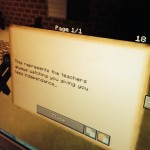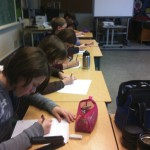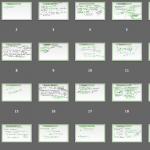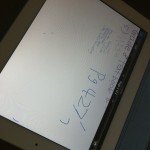
I asked my students this question. How do you acquire knowledge? 95% said – Books and Youtube/Internet (the other way around, actually). About 5 % said Teachers. Ouch. As I write this post, my son sits across the table watching a video/story about Minecraft World. He tells me that this is how he “learns how to craft”. My other son reads Reddit threads to learn/improve his skills on Java.
Matt Henderson asked me to think about and share my opinions of the following question:
How do people acquire knowledge and how can teachers facilitate this process effectively?
My quick answer- books.
I can’t help but think about the Printing Press of the 1400’s and forward. I am quite certain that when books and newspapers were made readily available to more people, the ability to learn and acquire knowledge must have grown exponentially. No doubt, the Printing Press changed the world.
Then we added an audio medium (although I know it was audio way before that, when people just told stories), when the radio (early 1900’s) was invented and the audience got even bigger. Not to mention, those who couldn’t read for whatever reason, suddenly had an opportunity – a freeing opportunity – to listen and learn. Again, a fine example of extending knowledge and information to a broader context. There is no doubt, the radio changed the world.
Then, a few decades later came the Television. There are still people alive today that can talk about how both, the TV and Radio changed their lives. With all these methods of information delivery (books, text, audio, video), the message was still based on a certain perspective, value or point of view. This, we know, can (and did) cause enormous suffrage.
How we acquire and interact with information changed yet again, introducing another medium. Along with the internet, we have portable ‘vehicles’ or ‘vessels’ that can share information, not just in print, but now, in combination with audio, video and text. And to take it further, we can change, edit, create and re-create the information in pairs, teams, groups, classrooms and communities regardless of our space or location.
With this said, I change my previous answer. How I acquire information and “knowledge” is no longer dependent on a single source or text, but on my ability to gather a variety of ideas, opinions, and research that are ever changing and then employ collaborative and ongoing change. It also depends on a burning question or an inquiry that I simply MUST know. Quite honestly, it is inspiring and empowering to find my own answers and exciting to know that my answers lead to more ideas, more information and more knowledge.
Admittedly, I am slightly frustrated that so many our school systems continue to teach students based on the model invented by Printed Press. Or, that we continue to drive information and knowledge that is based on a single point of view (picked by a publisher). Our textbooks, content standards and even our standardized tests are often outsourced regardless of the fact that communication technologies can bring in access to information…to people…to communities all over the world.
As teachers, we need to embrace the idea of blended learning and the use of a variety of technologies and mediums. Online, there are communities and resources where students can engage in rich discussions, problem based tasks, authentic inquires – but with a variety of supports and mediums. While in-class, students and teachers can share meaningful discussions and can use their understanding of the entire person (voice, body language, eye-contact, physical /mental health) to guide needs and next steps. Teachers can coach students through thoughtful and provoking questions and as a way to get them to think more deeply about the topic, to want to learn and find more.
Again, Matt asks me to reflect on how I personally acquire knowledge and foster acquisition in my learning environment.
I can look up and learn in any format that I need and self-evaluate until I am certain that I fully understand the skill or drill. I am no longer at the mercy of that single, all knowing, knowledge possessing teacher/leader. My resource pool has grown from the single textbook or course article to many many many sources and people, primary and secondary – including my students! I have become more critical of information and resources which has led me to think more deeply and reflect more authentically.
I recently wrote an article that discusses the dichotomies of Assessment in Education and I think this relates well to this topic, probably because in education we are consistently finding ways to Assess if and how our students have acquired knowledge and yet, the dichotomy of how students are acquiring knowledge in their “real” lives is quite different then their experiences at school with learning.
The Assessment Barrier – http://www.cea-ace.ca/blog/zoe-branigan-pipe/2013/10/5/assessment-barrier
“There is no reason that students today need to feel isolated or trapped by assessment. Learners can access facts and information in a variety of ways – if we let them.
Teachers can provide assessment and feedback in multiple of ways. Students can apply their learning to creative and real world situations – if we trust them. They can show their learning in audio and visual formats – if we show them. They can use online tools to review and master new skills and can collaborate or discuss ideas anytime and from anywhere – if we encourage them.
Educators today, can access professional development, current information, networks of learners and online tools in ways that didn’t exist even a decade ago. The assessment barrier is only a reality – if we let it be.





 2)
2)